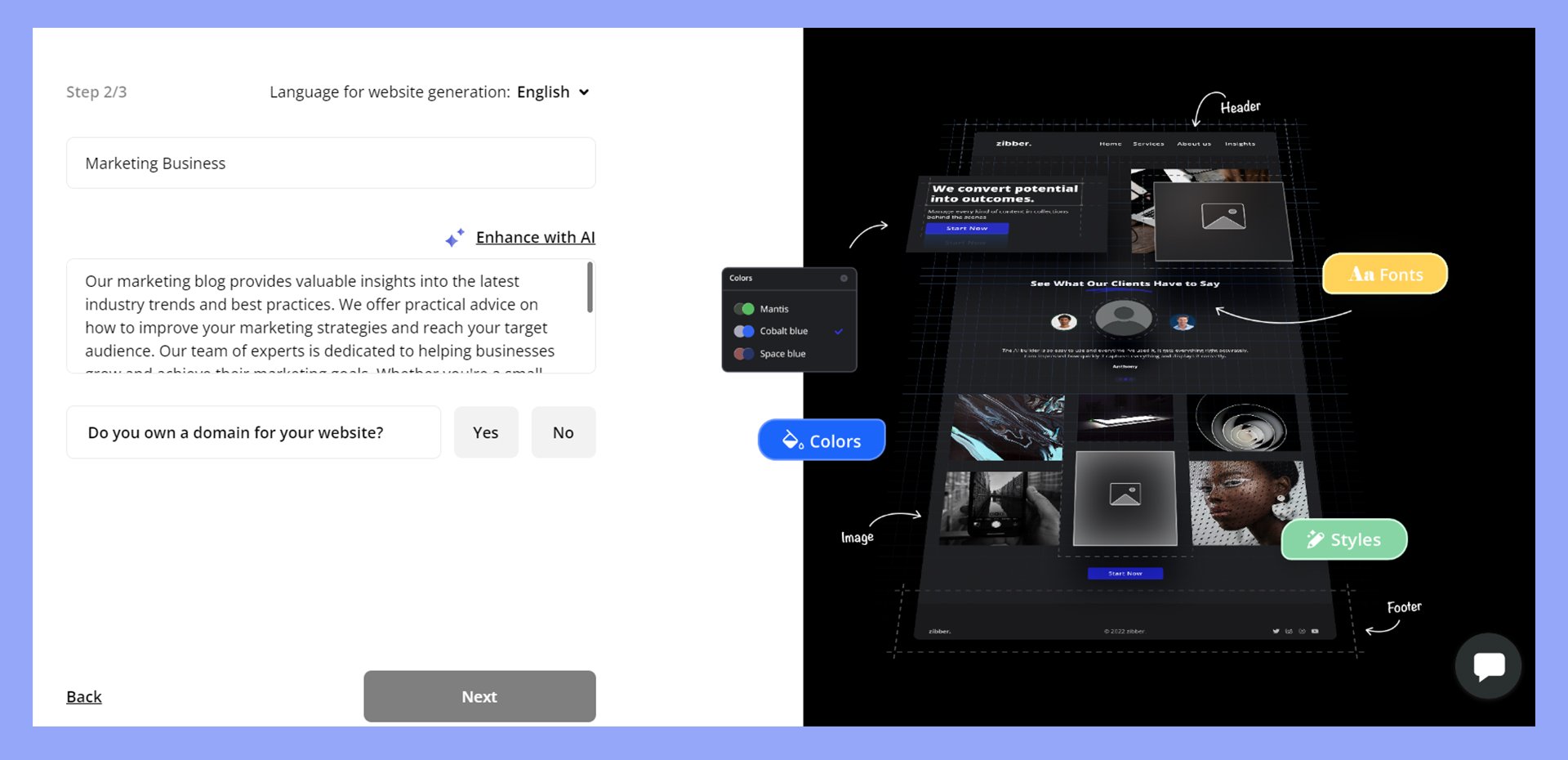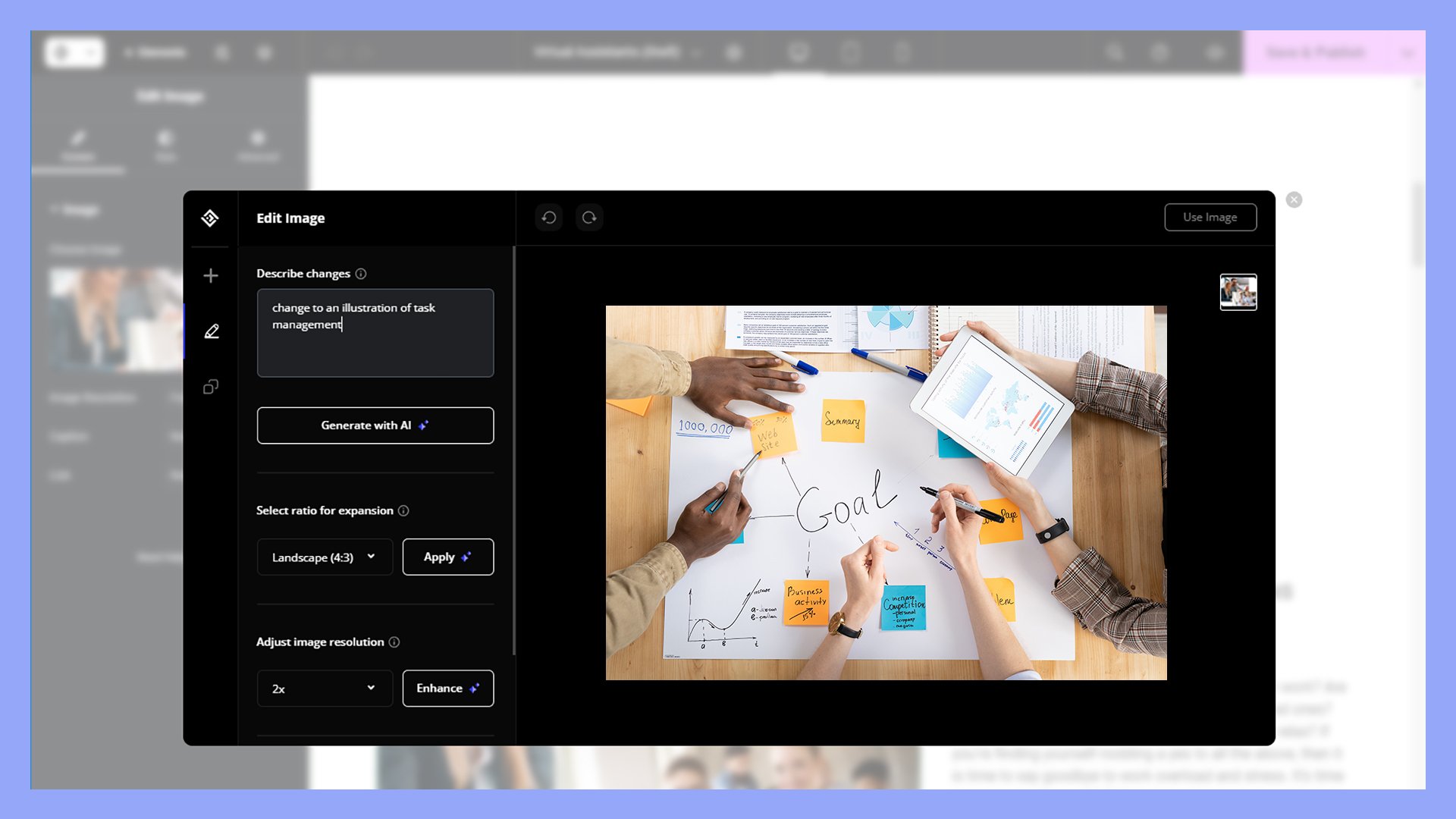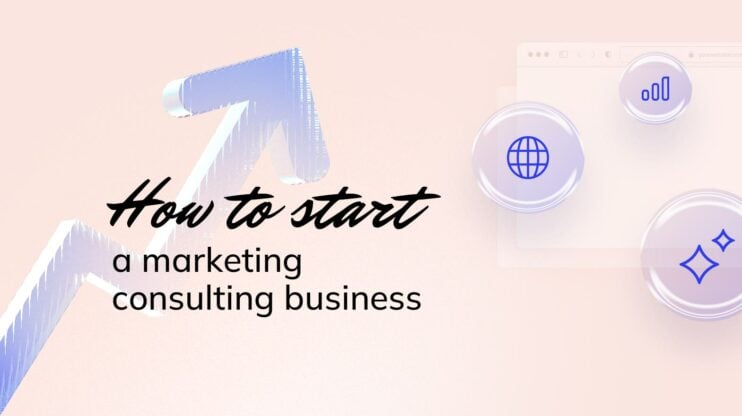Starting a marketing business presents exciting opportunities for creativity and innovation. The initial stage involves building a solid foundation with industry knowledge, skill enhancement, niche selection, and a comprehensive business plan. This groundwork sets the stage for success.
FAQ
How do I become a marketing business?
How do I start a marketing startup?
How do I start a marketing company with no experience?
How profitable is a marketing business?

Looking to sell online?
Create your custom online store in minutes with 10Web AI Ecommerce Website Builder and take your business online.
Stage 1: Starting a marketing business
Starting a marketing business requires a solid foundation. This includes industry knowledge, skill enhancement, niche selection, and business plan creation.
These steps will give you direction and help you achieve your business objectives.
Understanding the marketing industry
The marketing industry is vast and constantly evolving. It’s important to grasp market trends, popular tools, and strategies.
You’ll need to be familiar with digital marketing, content marketing, SEO, social media, and traditional methods.
Joining industry groups and attending workshops can be valuable. You can also read industry blogs, follow thought leaders, and subscribe to marketing journals. This will help you stay updated on new trends and tools.
Step 1. Assessing and building your skill set
Take a look at your current marketing skills and experience. Identify your strengths and areas that need improvement to start a marketing business effectively.
Consider online courses, certifications, and workshops to improve your skills.
It is essential to practice and apply your skills to real-world projects regularly. Working with mentors or joining marketing communities can also provide insight and support.
Skills like analytics, writing, and strategy planning are essential.
Step 2. Determining your marketing business niche
Specializing in a niche can set you apart from competitors. Think about the areas of marketing you enjoy and are good at. Also, different niches’ market demand and potential profitability should be considered.
Conducting market research will help you understand target markets and their needs. Create a buyer persona to identify your ideal client.
Based on this, pick a niche that aligns with your skills and market demand.

Step 3. Crafting a business plan
A business plan provides a roadmap for your new venture. It should include your business objectives, target market, services, and marketing strategies.
Outline your short-term and long-term goals.
Include a financial plan with budget forecasts and revenue projections. Identify milestones to track your progress.
This document should guide your business decisions and help secure potential investors or partners.
Step 4. Legal and financial considerations for marketing businesses
Starting a marketing business involves handling both legal and financial aspects. Setting up a proper business structure and managing your finances effectively is crucial to ensure smooth operations.
Setting up your business structure
Choosing the right business structure is essential. Most marketing businesses start as a Limited Liability Company (LLC) because they offer flexible tax options and protect personal assets.
You might also consider other structures like Sole Proprietorship or Corporation, depending on your needs.
After deciding on a structure, register your business with the state where you plan to operate. This often involves filing the necessary documents, paying a fee, and obtaining licenses specific to your industry.
Businesses must also apply for an Employer Identification Number (EIN) from the IRS, which is essential for tax purposes and hiring employees.
Managing finances and budgeting
Effective financial management is key for marketing businesses. Start by opening a business bank account to keep your personal and business finances separate.
This simplifies accounting and provides a clear picture of your income and expenses.
Create a detailed budget listing all your expected costs. Include areas like marketing, salaries, office supplies, and technology.
Regularly review your budget and adjust as needed to stay on track. Use accounting software to manage finances and track your expenses easily.
Setting up a bookkeeping system from the beginning helps prevent financial mishaps. Hire an accountant or use software like QuickBooks to monitor your financial health accurately and ensure you comply with all tax regulations.
Step 5. Developing your marketing business brand
In this step, you will focus on creating a unique brand identity. You will also learn how to build brand awareness, establish your online presence, and utilize content marketing to strengthen your marketing business brand.
Building a brand identity for a marketing business
Your brand identity is how you want your business to be perceived by customers. Start by determining your brand’s purpose and values. Ask yourself what sets your business apart from competitors.
Next, choose a memorable brand name. This could be something simple or a combination of words related to your business. Make sure it’s easy to spell and remember.
Create a logo that represents your business visually. This should be professional and reflect the essence of your brand.
A consistent color palette and font type across all materials will help solidify your brand’s identity.
Develop your website to showcase your brand. Your website should be user-friendly and optimized for search engines to drive brand awareness.
Integrate your logo, color scheme, and fonts to reinforce your branding.
Use content marketing to connect with your audience. Create blogs, videos, or social media posts related to your industry. Share your brand’s story and values through engaging content to attract and retain customers.
Lastly, monitor and adapt your branding strategy. Pay attention to customer feedback and market trends, and adjust your branding efforts as needed to stay relevant and maintain a strong online presence.

Looking to sell online?
Create your custom online store in minutes with 10Web AI Ecommerce Website Builder and take your business online.
Stage 2: Setting up a marketing business for success
To succeed as a marketing business, you must have a plan for offering services, pricing, and a professional web presence to tie it all together.

Step 1. Creating an online presence for a marketing business
To start a marketing business, having a strong online presence is vital. This includes choosing a domain name, building a business website, and establishing a social media profile.
Choosing a domain name
Your domain name is your online address, so it should be unique and easily remembered. Here are some tips:
- Keep it short and simple
- Use keywords related to your business
- Avoid numbers and hyphens, which can be confusing
- Check availability on domain registration sites
Choose a name that reflects your brand while being easy to type and spell.
Finding the best website platform for marketers
Choosing a website platform can feel overwhelming. Look for these features:
- Ease of use: A platform like WordPress is popular for its intuitive interface.
- Customization: Platforms should offer templates and customization options.
- SEO tools: Optimize your site to rank well in search engines.
Remember that some platforms, like 10Web’s AI-powered WordPress builder, make it simple to create a professional marketing business site quickly with AI-generated content.
Starting a marketing business website with AI
Using 10Web AI makes website building straightforward and efficient. Here’s how to get started:
- Sign up on 10Web’s platform.

- Answer questions about your business to tailor the content.

- Generate your website: The AI creates a complete site with original content and layout.
- Customize: Use the drag-and-drop builder to tweak text, images, and layout to match your brand.

- Set up hosting: 10Web provides automated web hosting, simplifying maintenance.
Within minutes, you can have a functional, personalized website ready to go live.

Looking to sell online?
Create your custom online store in minutes with 10Web AI Ecommerce Website Builder and take your business online.
Building a social media presence
Social media platforms are essential for reaching your audience. Follow these tips:
- Identify the right platforms: LinkedIn, Facebook, and Instagram are great for marketing businesses.
- Create engaging profiles: Use your business name, logo, and a brief description of your services.
- Post regularly: Share valuable content like blog posts, updates, and industry news.
- Interact with followers: Respond to comments and messages to build relationships.
Engaging on social media increases visibility and attracts potential clients.
Step 2. Building your offerings as a marketing business
Starting a successful marketing business requires defining your services clearly and developing strategic service packages and pricing. These offerings will help showcase your value and attract clients effectively.
Developing marketing service packages
Start by making a list of all the services you can offer. Consider different marketing activities, such as social media management, email campaigns, SEO, content creation, and paid advertising. Each of these services can be a part of your offerings.
Next, create packages that combine related services.
For example, you could have a Basic Package that includes social media management and email campaigns, a Standard Package that adds SEO and content creation, and a Premium Package that includes all services and paid advertising.
When creating these packages, remember that the goal is to provide value to your clients.
Understand the target market’s needs and tailor your packages to solve their problems. Clearly outline what each package includes using bullet points or tables to make it easy to understand.
Pricing your services
Setting the right price for your services is crucial. Start with competitive analysis. Look at what other marketing businesses in your area or niche are charging. This will give you a sense of the market rates.
Consider the value you provide.
Packages that offer more comprehensive services should be priced higher, but they must reflect their worth to the client. Make sure your prices cover your costs and allow for a profit.
You can structure your pricing in different ways.
Hourly rates, monthly retainers, or per-project fees are all options. Communicate the pricing in your proposals and on your website. Transparency builds trust with potential clients.
Step 3. Managing projects and clients
Successfully managing projects and clients is crucial for a thriving marketing business. This involves setting up effective billing systems, ensuring timely payments through well-managed invoices, and utilizing the right tools and software.
Setting up billing systems
Setting up a reliable billing system is important to keep your finances in check.
First, decide on the type of billing you will use, such as hourly or project-based. Each method has its own set of advantages.
Create detailed invoices that outline your services, rates, and payment terms.
Use templates to save time and maintain consistency.
You may consider using billing software like QuickBooks or FreshBooks to automate the process and reduce human error.
Clear communication about payment schedules and late fees helps avoid misunderstandings.
This ensures you have a steady cash flow and clients understand their financial commitments.
Managing invoices and payments
Once your billing system is in place, managing invoices and payments becomes essential for smooth operations in your marketing business.
Start by setting up a calendar to track the due dates for all your invoices. This will help you send timely reminders to clients and ensure prompt payment.
Use software like Xero to generate and send invoices. These tools allow you to track payment statuses and send follow-up reminders automatically.
A clear record of all transactions is crucial for financial health and tax purposes.
Clearly state your payment terms on every invoice. Specify due dates, accepted payment methods, and penalties for late payments.
Clear terms help maintain professionalism and ensure clients understand their obligations.
Tools and software for managing projects and clients
Utilizing tools and software can greatly improve your marketing business’s management of projects and clients.
Popular project management tools like Trello, Asana, and Monday.com help you plan tasks, set deadlines, and assign responsibilities. These platforms also enable team collaboration.
Client management software like HubSpot CRM and Zoho CRM helps track client interactions, manage leads, and automate communication.
These tools store all client information in one place, making it easier to provide personalized services.
Using these tools improves your efficiency and helps prevent miscommunication.
This ensures that projects run smoothly and clients are satisfied with your services.
Stage 3: Promoting and raising brand visibility
You need effective strategies and tactics to succeed in starting a marketing business. This involves planning specific actions to reach your target audience and achieve your goals.
Set SMART goals
Specific: Be clear about your goals.
Measurable: Ensure you can track progress.
Achievable: Set realistic goals.
Relevant: Align goals with your business.
Time-bound: Set a deadline.
Step 1. Marketing strategies and tactics
Starting a marketing business requires effective strategies and tactics. These include mastering SEO, leveraging social media, exploring email and content marketing, and utilizing analytics.
Mastering SEO techniques
To start, search engine optimization (SEO)is crucial. By optimizing your website, you improve your visibility on search engines like Google.
Use relevant keywords in your content. Ensure your website is mobile-friendly.
Quality backlinks from reputable sites can boost your site’s authority.
Make sure your website loads quickly because site speed affects SEO.
- Use keyword research tools to find relevant keywords.
- Optimize your title tags and meta descriptions.
- Create high-quality content that answers users’ questions.
Leveraging social media marketing
Social media platforms like Facebook, Instagram, and Twitter allow your marketing business to build relationships and reach new audiences.
Create engaging content tailored to each platform. Use graphics, videos, and interactive posts to increase engagement.
Schedule your posts for consistent activity using social media management tools like Hootsuite or Buffer.
Steps to enhance social media presence:
- Create a content calendar for regular posts.
- Engage with your audience through comments, likes, and shares.
- Use analytics tools provided by social media platforms to track performance.
Exploring email and content marketing
Email marketing allows a marketing business to reach customers directly in their inboxes.
It’s cost-effective and can yield high returns.
Use personalized email campaigns to build relationships. Segment your audience to send targeted messages.
Pair email marketing with content marketing by sharing blog posts, newsletters, and other valuable content.
Effective email and content marketing strategies:
- Use eye-catching subject lines to increase open rates.
- Include clear calls to action (CTAs) in your emails.
- Create informative, engaging content that addresses reader needs.
Utilizing analytics and SEO
Tracking the performance of your marketing efforts is crucial.
Use Google Analytics to monitor your website traffic and user behavior. Analyze metrics like page views, bounce rates, and conversion rates.
This data helps you understand what’s working and where improvements are needed.
Key analytics practices:
- Set up goal tracking to measure conversions.
- Regularly review your analytics dashboard.
- Make data-driven decisions to refine your marketing strategies.
Step 2. Content creation and management
To start a marketing business, you must focus on developing a content strategy, creating valuable content, and effectively using case studies.
Developing a content strategy
First, outline your goals. Do you want to generate leads or increase brand awareness? Define what you want to achieve with your content.
Next, research your target audience.
Develop buyer personas by identifying your ideal customer’s age, interests, and challenges.
Make a content calendar. Plan what you’ll post and when. This helps you stay organized and consistent.
Creating valuable and shareable content
Create content that answers your audience’s questions. Write blog posts, make videos, and encourage user-generated content like reviews and testimonials.
Use keywords to improve SEO. This helps your content rank higher on search engines, making it easier for people to find.
Focus on quality over quantity. Valuable content is well-researched, informative, and engaging.
Make your content shareable. Use compelling headlines, include social share buttons, and add visuals to increase shareability.
Creating and using case studies effectively
Case studies show potential clients how your marketing business solved problems for others, building trust and credibility.
First, identify a successful project to highlight. Get permission from the client to use their experience as a case study.
Include the following parts in your case study:
- Background: Briefly describe the client and their industry.
- Challenge: Explain the problem the client faced.
- Solution: Detail how your service helped solve the problem.
- Results: Share measurable outcomes like increased sales or web traffic.
Use visuals like charts to illustrate achievements. Finally, promote your case studies on your website and social media.
Step 3. Leveraging advertising platforms
To start a marketing business, you need to use advertising platforms effectively. These tools help you reach a wider audience, target specific demographics, and measure the effectiveness of your campaigns.
Navigating paid advertising channels
Paid advertising channels are essential for growing your business.
Platforms like Facebook, Instagram, and Google Ads allow you to target precise audiences based on demographics, interests, and behaviors.
First, create business accounts on these platforms.
Then, explore options like Facebook Ads Manager and Google Ads to set up your campaigns.
Next, define your target audience by adjusting settings in Audience Insights on Facebook or Keyword Planner on Google.
Choose placements wisely: Facebook and Instagram offer feed, story, and sidebar ads, while Google provides search and display network options.
Finally, monitor and adjust your ads using built-in analytics.
Track metrics like click-through rates (CTR), cost-per-click (CPC), and conversion rates to ensure your campaigns meet goals.
Crafting compelling ad campaigns
Creating engaging ads is vital to capturing your audience’s attention.
Start by crafting a clear and attention-grabbing headline.
Use strong visuals that convey your message quickly.
For text-heavy platforms like Google, focus on keywords that match user queries and write concise, compelling descriptions.
Eye-catching images or videos perform better on visual platforms like Facebook and Instagram.
Use tools like Canva or Adobe Spark to design your graphics.
Include a clear call-to-action (CTA) in every ad.
CTAs like “Shop Now,” “Learn More,” or “Sign Up” guide users toward the desired action.

Looking to sell online?
Create your custom online store in minutes with 10Web AI Ecommerce Website Builder and take your business online.
A/B tests can help determine which ad formats, headlines, and visuals resonate best with your target audience.
Continually review and optimize your ad performance regularly to enhance engagement and ROI.
Step 4. Client Acquisition and Retention
To build a successful marketing business, attracting and retaining your first clients is crucial to building strong relationships.
Identifying and attracting first clients
Start by identifying your target audience. Based on demographics, behaviors, and preferences, create detailed buyer personas. This will help you understand your ideal clients and tailor your services to meet their needs.
Next, various channels should be used to reach these potential clients. Social media, search engines, and email marketing effectively attract leads. Share valuable content, engage with your audience, and highlight what makes your marketing business unique.
Offering free consultations or introductory discounts can also entice potential customers. Once you’ve caught their interest, focus on converting leads into paying clients by demonstrating the value of your services.
Building strong client relationships
Once you’ve acquired clients, building and maintaining strong relationships with them is essential. Start with a smooth client onboarding process. Ensure all necessary information is exchanged and set clear expectations.
Regular communication is critical to nurturing client relationships. Update your clients on project progress and seek their feedback. Use tools and software to manage projects and clients efficiently. Platforms like Trello, Asana, or HubSpot can help keep everything organized.
Deliver on your promises and consistently provide high-quality work. Show appreciation by acknowledging their loyalty and offering special deals or personalized services. Building trust with your clients ensures long-term relationships and can lead to referrals and repeat business.
Step 5. Scaling your business
Scaling your marketing business involves expanding your client base and building a cohesive, capable team. This process requires strategic hiring and considering options for outsourcing and partnerships.
Hiring talent and building a team
To scale effectively, you must hire talented and motivated employees who believe in your mission. Start by identifying key roles that need filling to support your business growth. Look for individuals who bring unique skills and can contribute to a dynamic team.
Investing in high performers can significantly enhance productivity. Research shows top performers can be substantially more productive than average employees, so careful hiring decisions are crucial. Implement a rigorous interview process to ensure you hire the right people for your growing business.
Creating a positive work environment and offering competitive compensation packages are also essential. This helps retain top talent and keeps your team motivated. Regular training and development programs will further enhance your team’s skills and align everyone with your business goals.
Considering outsourcing and partnerships
Outsourcing can help manage workload without the overhead costs of full-time employees. Consider hiring freelancers or agencies for content creation, graphic design, or administrative work. Outsourcing lets you focus on high-priority areas and maintain flexibility as your needs change.
Building partnerships with other businesses can also drive growth. Collaborating with other companies allows you to access new customer bases and share resources. Look for partners whose services complement yours, creating a mutually beneficial relationship.
Effective outsourcing and strategic partnerships can provide the support and expertise your business needs to scale efficiently. Keep communication clear and establish expectations upfront to ensure smooth collaborations.
Networking for growth
Building a marketing business involves engaging with industry professionals and participating in events. Developing solid relationships through these activities can significantly boost business growth.
Engaging with industry networks
To grow your network, start by joining industry-specific LinkedIn groups. These groups are valuable for connecting with peers, mentors, and potential clients. Regularly participate in discussions and share your insights.
Creating a presence in these networks can enhance your credibility. Follow relevant professionals and comment on their posts to start conversations. Building genuine relationships is vital. It’s about what others can do for you and how you can help them.
Partnering with other businesses for joint ventures or marketing campaigns can benefit both parties. This collaboration helps reach a wider audience and leverage each other’s strengths.
Attending and hosting events
Attending networking events is essential for face-to-face interactions. These events could be webinars, industry conferences, or local meetups. Use these opportunities to introduce yourself, exchange business cards, and follow up on LinkedIn.
- Prepare: Have your elevator pitch ready.
- Engage: Ask questions and actively listen to others.
- Follow-up: Connect on LinkedIn and send a personalized message after meeting someone new.
Hosting your own events can also be a powerful networking tool. Whether it’s a small workshop or a more extensive seminar, you position yourself as an industry leader. Promote your events through LinkedIn and other social media platforms to attract attendees.
Step 6. Measuring success and ROI
To ensure your marketing business thrives, it’s essential to measure the impact of your efforts and refine your strategies to maximize your Return on Investment (ROI). This involves analyzing your marketing activities and adjusting to improve profitability and support business growth.
Analyzing marketing impact
Understanding how well your marketing efforts perform requires carefully tracking and analyzing various metrics. Start by setting goals for each campaign, such as increasing website traffic, boosting sales, or gaining more social media followers.
- Track key metrics: Use tools like Google Analytics to track website visits, click-through rates, and conversion rates.
- Sales data: Compare the sales data before and after your marketing efforts to see the direct impact on revenue.
- Customer feedback: Collect and analyze customer reviews and feedback to gauge their response to your campaigns.
Creating reports with these metrics helps you identify what is working well and what isn’t, enabling you to make data-driven decisions moving forward.
Refining strategies for better ROI
Once you’ve analyzed your marketing impact, it’s time to refine your strategies to improve your ROI. Look at your collected data to see where you can make adjustments.
- Optimize budget allocation: Allocate more budget to high-performing channels and reduce spending on less effective ones.
- A/B testing: Continually test different versions of your ads or content to see which performs better.
- Customer retention: Focus on strategies that improve customer retention, as retaining customers often costs less than acquiring new ones.
Make your marketing plan flexible enough to adapt to these changes. Refining your strategies ensures you get the best possible return on your marketing investments and drives ongoing business growth.
Step 7. Overcoming common roadblocks
Starting a marketing business is exciting but also full of challenges. Here are some common roadblocks and how you can tackle them:
- Funding issues: Money is crucial to starting your marketing business. You can apply for a loan or seek investment from friends or family.
- Creating unique content: Coming up with fresh ideas can be tough. Follow industry experts and use tools like BuzzSumo to see what’s trending.
- Staying focused: It’s easy to get overwhelmed. List your top priorities and focus on those.
- Building a client base: Without clients, there’s no business. Network at industry events and use LinkedIn to connect with potential clients.
Common challenges and solutions
| Challenge | Solution |
| Limited budget | Seek funding options like loans or investors |
| Difficulty in content creation | Use content idea tools and industry insights |
| Lack of client leads | Network and leverage social media platforms |
Tips for long-term success and growth
- Keep learning: Marketing trends change fast.
- Take courses and stay updated.
- Adapt to feedback: Listen to what your clients say.
- Make adjustments to your services based on their feedback.
- Stay passionate: Love what you do, and success will follow.
Building a successful marketing business
In conclusion, starting a marketing business involves several strategic steps. Begin by laying a solid foundation with industry knowledge, skill enhancement, and a well-defined niche.
Develop a robust business plan and address legal and financial considerations. Build a strong online presence, craft compelling service packages, and establish effective client management systems. Leverage advertising platforms and networking opportunities to attract and retain clients. Continually measure success and refine strategies to maximize ROI.
Following these steps, you can create a successful marketing business that adapts to market trends and client needs, ensuring long-term growth and success.


















